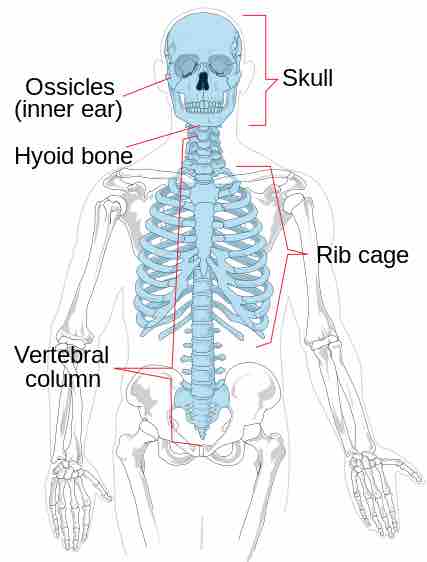The axial skeleton is the part of the skeleton that consists of the bones of the head and trunk of a vertebrate animal, including humans. The word axial is from the word axis, and refers to how the bones of the axial skeleton are located along the central axis of the body.
The axial skeleton functions to support and protect the organs of the dorsal and ventral cavities. It also serves as a surface for the attachment of muscles and parts of the appendicular skeleton.
The human’s axial skeleton is composed of 80 bones and is the central core of the body. The primary divisions of the skeleton system are:
- Head, including the bones of the skull (cranium), face, auditory ossicles, and hyoid bone.
- Thorax, including the rib cage and sternum.
- Vertebral column.

Axial skeleton
Image depicting the human skeleton with the axial skeleton.
Bones of the Head
Skull (Cranium)
The human cranium consists of the flat bones of the cranium and includes the facial bones. The cranium protects the brain that is contained in the cranial vault. The cranium is formed from eight bones connected by sutures.
Fourteen facial bones form the lower front part of the cranium. Important facial bones include the lower jaw or mandible, the upper jaw or maxilla, the zygomatic or cheek bone, and the nasal bone.
The immature cranium has separate plates to allow the flexibility needed for a newborn to pass through the birth canal and pelvis. These plates fuse as the skull matures (except the mandible). The human cranium supports the structures of the face and forms the brain cavity.
Ossicle
The ossicles (also called auditory ossicles) consist of three bones (malleus, incus, and stapes) that are the smallest in the body. These are located in the middle ear and serve to transmit sounds from the air to the fluid-filled labyrinth.
Hyoid Bone
The hyoid bone is a horseshoe-shaped bone situated in the anterior midline of the neck between the chin and the thyroid cartilage. It provides attachment to the muscles of the floor of the mouth, the tongue above, larynx below, and the epiglottis and pharynx behind.
Rib Cage
The rib cage is composed of 25 bones that include the 12 pairs of ribs plus the sternum. It functions as protection for the vital organs of the chest, such as the heart and lungs. The rounded ends are attached at joints to the thoracic vertebrae posteriorly and the flattened ends come together at the sternum anteriorly.
The first seven pairs of ribs attach to the sternum with costal cartilage and are known as true ribs. The length of each rib pair increases from number one to seven. After rib seven, the size begins to decrease. The 8th through 10th ribs have noncostal cartilage that connects them to the ribs above.
The last two ribs are called floating ribs because they do not attach to the sternum or to other ribs.
Vertebral Column
There are normally thirty-three vertebrae in the human vertebral column. The upper twenty-four articulate and are unfused, the lower nine are fused. The fused vertebrae are the five in the sacrum and four in the coccyx.
The articulating vertebrae are named according regions:
- Cervical vertebrae (seven vertebrae).
- Thoracic (twelve vertebrae).
- Lumbar (five vertebrae).
The first and second cervical vertebrae are the atlas and axis, respectively, on which the head rests. The cervical vertebrae make up the junction between the vertebral column and the cranium, and the bone makes up the junction between the vertebral column and the pelvic bones.